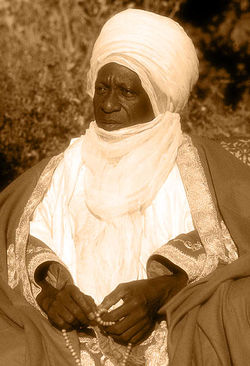Archive:King Vereq Henuut
 | This article or section is dead content. This has been fully retconned from Sahar, and is no longer considered canon. This page was last edited by Ava (talk | contribs) 17 days ago. (Update) |
| Tolyar Vereq 'ad Henüüt | |
|---|---|
 Henuut II at age 68 | |
| King of Tabiqa | |
| Reign | November 3 1919 - December 19 1950 |
| Predecessor | Tolyat Henüüt 'ay Zidriiža |
| Successor | Tolyat Isaemat 'ay Avhidi |
| Born | 11 June 1881 Mehyaran, Tabiqa |
| Died | 1 February 1954 (aged 72) Mehyaran, Tabiqa |
| Spouse | Tera Avhidi 'ad Antuuröt |
| Mother | Tolyat Henüüt 'ay Zidriiža |
King Vereq Henuut (Adzamasi: Tolyar Vereq 'ad Henüüt, IPA: /tʌljɐχ fɛʁɛq ʔɐd hɛny:t/), also known as Henuut II, was the last monarch with a fully autocratic reign of Tabiqa. He ruled from 1921 until the 1950, near the end of the Great Ekuosian War, after which he was forced to abdicate the throne, and the country adopted a constitutional monarchy.
Early life and marriage
Born to Queen Henuut Zidrizha (Henuut I), Vereq was the second of five children, with one older sister, Ithesa 'ay Henuut, who was expected to serve as their mothers' successor. Nevertheless, Vereq and all his siblings were educated in the ways of rulership and politics, and were expected to be given more minor roles or stations in the country.
Ithesa, two years his senior, was greatly weakened by an appendectomy in her early twenties after showing signs of acute appendicitis. She never fully recovered from the illness and the emergency surgery; and so Vereq became the designated heir at age twenty-one. Following this, his marriage was arranged to Avhidi 'ad Antuuröt, princess from the royal line of the province of Itq̇ar. They wed at ages 29 and 26 respectively, eventually producing six children: Isaemat (1909), Biṫosar (1913), Nahdiir (1918), Qamarq (1924), and twins Ittenat and Šoviiv (1927).
Rule
Early reign
Vereq ascended the throne in 1919, aged 38, when his mother, then aged 75, voluntarily abdicated.
Vereq was well-liked by most Tabiqiri in his early reign; he was seen as charismatic, forward-thinking, and above all else, competent. He helped to bring about several quality-of-life changes for many Tabiqiri, putting significant sums from the royal treasury towards improving the sanitary systems of Mehyaran and Ziathi, the building of multiple bridges across the Tabiq river to neighbouring Barradiwa, and improving codes for building, education, and health care. However, many of these improvements were concentrated in primarily-Adzamasiin locales. He also updated several obsolete and oppressive feudal-era laws, but sometimes only in reference to those with official Adzamic ancestry.
In the 1930s and 40s, as part of a lead-up to the Great Ekuosian War, influenced by rising fascism in some parts of Ekuosia, Vereq instituted increased quotas for military conscription, and began decreasing certain civil liberties, especially for the Kõ citizens of Osur province, among whom an organized separatist trend was growing. This sparked age-old ethnic tensions and resulted in subjugation of the Kõ people; several hundred died as a result of the reduction of essential services, mostly during the 1941 Taihar flood catastrophe, in which relief efforts were hindered by an unsympathetic military. Thousands of others were left homeless during this period, and many faced violence.
Great Ekuosian War
Vereq began losing popular support during the invasion of Barradiwa of the GEW. While many Adzamasiin agreed with the intention as presented in propaganda (to liberate their Dzimrani cousins from non-Adzamic rule), many disagreed with invading a state that had been their long term ally. The invasion also required yet greater numbers of soldiers and increased taxation, a levy that was particularly resented by the already-beleaguered Kõ. A few years into the invasion, unrest had grown to the point that a civil war broke out in the country, dramatically reducing its military effectiveness in the international conflict.
The King suffered a massive stroke in early October 1950, resulting in partial paralysis and ongoing health issues that would lead to his death four years later. This marked a turning point in the ongoing conflicts for Tabiqa, as his illness provoked further unrest from the public and demoralized his supporters. By November, his eldest daughter Isaemat had become the de facto leader of the country, and was working against his will towards ceasefires on all fronts.
He formally abdicated the throne in December 1950, at which point Isaemet was crowned Queen. Vereq remained a figure of public interest and maintained some loyal supporters, who disagreed with many of Isaemet's more liberal policies; under her rule, Tabiqa became a democratic constitutional monarchy. Vereq was noted to steadfastedly refuse his right to cast a ballot in the first national election in 1952, and is widely quoted as saying "The only person worth voting for [myself] is not on the ballot."
Death and Legacy
He died of a second coronary event on February 1st, 1954, age 72. The following day was marked as a day of national mourning; thousands of Tabiqiri came to the palace in Mehyaran to pay their respects, while in farther reaches of the country fighting broke out between crown loyalists, separatists, and other factions.
The Henuut line, directly descended from Vereq, continues to sit on the Tabiqan throne, although now in a mostly ceremonial role. The current king, Okmaruud, is his grandchild, son of his younger daughter, Ittenat.
Vereq remains a popular historical figure among Tabiqan monarchists and fascists, who often hold celebrations on his date of birth and coronation, and stage public protests on the anniversary of his death.